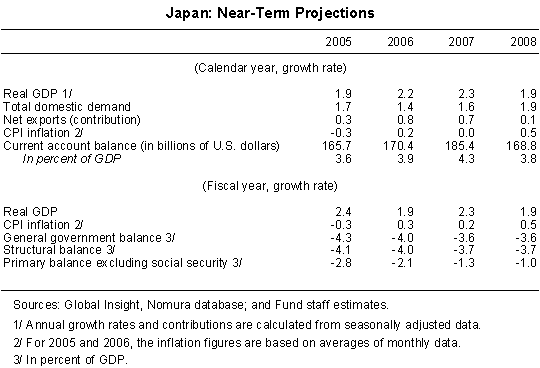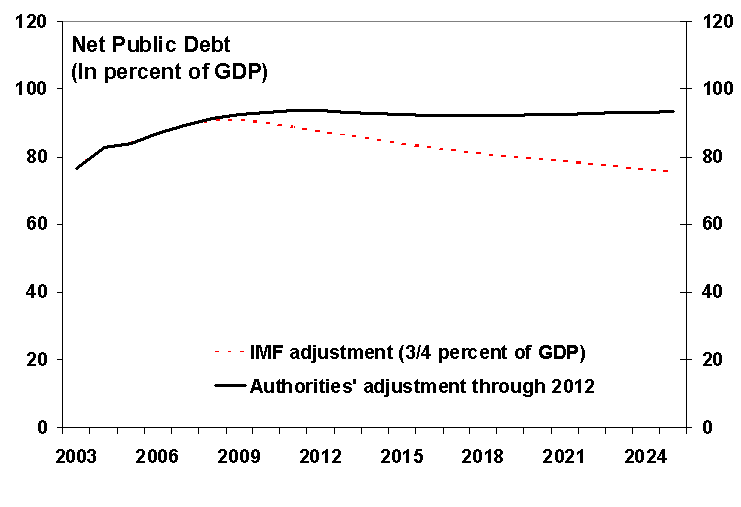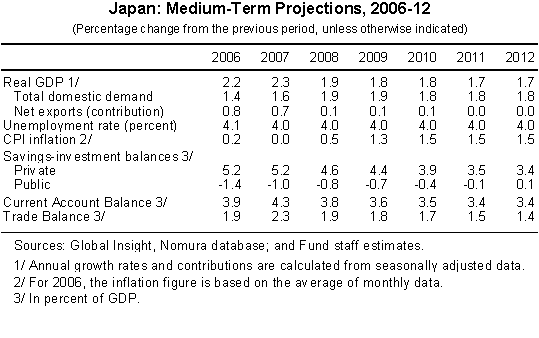2007 Article IV Consultation with Japan, Concluding Statement of the IMF Mission
May 24, 2007
Describes the preliminary findings of IMF staff at the conclusion of certain missions (official staff visits, in most cases to member countries). Missions are undertaken as part of regular (usually annual) consultations under Article IV of the IMF's Articles of Agreement, in the context of a request to use IMF resources (borrow from the IMF), as part of discussions of staff monitored programs, and as part of other staff reviews of economic developments.
This statement summarizes our preliminary policy recommendations. The favorable economic outlook provides a good opportunity to push ahead with the reform agenda. We agree with the authorities that the policy priorities remain to secure fiscal sustainability, foster growth and price stability, strengthen the financial system, and deepen reforms to boost productivity. Achieving these goals will help Japan reap the benefits—and meet the challenges—created by the quickening pace of globalization.
I. The Outlook
1. We share the authorities' view that the near-term outlook is favorable and the risks are balanced.
Baseline: We project GDP growth to be about 2¼ percent in 2007 and decline somewhat in 2008. CPI inflation will pick up as the economy operates close to potential, but the pace will be gradual, reflecting global competitive pressures, low inflation expectations, and persistent wage moderation. The current account surplus is expected to remain around 4 percent of GDP in 2007-08, supported by strong investment income inflows.
 Risks: Downside risks are mostly external, including a hard-landing in the United States, higher oil prices, and greater financial volatility from a global flight from risk. On the upside, a tight labor market could lead to faster growth in wages and consumption. II. Japan's Policies in a More Globalized World A. Reducing Public Debt to Achieve Fiscal Sustainability 2. We continue to believe that the time is right for a faster pace of fiscal consolidation. The greater-than-anticipated deficit reduction over the past three years has not held back the expansion. The authorities should be commended for adhering to their spending commitments and the progress made in reducing the deficit. But more remains to be done, as public debt remains uncomfortably high and pressures from an aging society build. Thus, there is a compelling case to save past gains and bring forward the timing for lowering the debt ratio. Faster progress will buy "policy insurance" against shocks and make room to cope with rapid population aging as well as support private spending. Faster consolidation will also be desirable in light of heightened market discipline in the JGB market due to the secular decline in home bias, growing foreign participation, and the likely shifts in Japan Post's assets as its privatization proceeds. 3. Our main observations concern the desirable pace of consolidation, the relative contribution of expenditure and revenue measures, and the strategy for tax reform.  On the pace of consolidation: Consolidation has proceeded faster than expected but largely because of exceptional increases in corporate tax revenue in the upswing. With the outlook still favorable, a more ambitious adjustment than in the authorities' medium-term scenario seems warranted. We would favor an adjustment to the primary balance of the general government excluding social security of about ¾ percent of GDP per year on average during 2007-2012, or nearly ½ percent of GDP more than in the authorities' reference path. This fiscal effort would lead to a primary surplus of 1-1½ percent of GDP and, if maintained, would put the debt ratio on a downward path beginning in 2010, rather than merely stabilizing it. Such a goal could be adopted in the context of a broader discussion of tax and expenditure reforms. On the composition: Every effort should be made to stick to the commitments to reduce public spending under the government's fiscal strategy. On this front, the recent initiative to consolidate the government's special accounts is welcomed and could help better control expenditures. However, while more can be done on the spending side, given the size of the needed adjustment it would be difficult to reduce the debt through expenditure cuts alone. Thus, additional revenue measures seem unavoidable. On strategy: Revenue measures could be best identified in the context of a broad reform of the tax system that also takes into account the challenges posed by globalization (for example, greater factor mobility and increased tax competition). Options include: (i) raising the consumption tax; (ii) revising the corporate tax system to promote innovation and competitiveness; (iii) widening the income tax base; and (iv) strengthening tax administration, including through tax-payer identification numbers. Compared with alternative revenue-enhancing measures, increasing the consumption tax would be more supportive of growth and more equitable, as a shift to indirect taxation would spread the burden more evenly across generations. Earmarking the consumption tax to the funding of social security programs is an option worth considering on pragmatic grounds. B. Monetary and Exchange Rate Policy in a More Globalized World 4. Monetary management has been appropriately supportive in the very low inflation environment. While low interest rates have created international spillovers by contributing to capital outflows and a weaker yen, these factors fall under the Bank of Japan's (BoJ) "second perspective" and should be considered in that context. With fiscal policy firmly set on consolidation and inflation close to zero, we share the view that monetary policy should remain focused on securing price stability and durable growth in Japan. The benefits from a stronger Japanese economy would be felt globally. 5. Our observations relate to the policy stance going forward and the role of the monetary framework in guiding market expectations. Policy stance: We support the BoJ's intention to be attuned to a range of incoming data in the months ahead and adjust its policy settings flexibly. On this basis, a gradual removal of monetary accommodation is appropriate. More precisely, given the more subdued inflation outlook in the near term and absence of worrisome financial imbalances, we think that a rate hike should be delayed until inflation expectations have recovered and the prospective CPI trend is firmly rising. This would also build in a "safety margin" to guard against negative shocks and the risks of returning to entrenched deflation. Operations of the monetary framework: The BoJ's monetary framework has helped to improve the public's understanding of the conduct of monetary policy. To strengthen further its effectiveness, the BoJ should continue to articulate how the framework will be implemented. This would entail continued communication of the BoJ's views on the outlook and the balance of risks. To that end, for example, greater use of forward-looking policy statements, particularly on the balance of risks, between the publications of the semi-annual "Outlook for Economic Activity and Prices" could better guide market expectations. With regard to the range of the "understanding of price stability," we agree that—notwithstanding recent price developments—the risk of falling prices and declining activity in a deflationary spiral is small. In addition, the range of inflation perceived by economic agents as consistent with price stability is unlikely to have changed much over the last year. Nevertheless, to better anchor inflation expectations in positive territory and in response to any concerns by market participants over the zero lower bound of the "understanding," communications of the monetary framework could emphasize more the fact that most Policy Board members' range of "understanding" of an inflation rate consistent with price stability falls on either side of 1 percent. 6. The market-oriented exchange rate policy remains appropriate. We continue to support the official policy that the yen exchange rate should reflect economic fundamentals and appropriate action will only be taken to counter excessive volatility and disorderly movements. We would not endorse intervention to strengthen the yen, which would be of uncertain effectiveness and could damage the credibility of the authorities' policy. By the same token, we would symmetrically suggest allowing the yen to appreciate if upward pressures emerged, since the economy can now cope with a stronger currency. C. Financial Policies for Enhancing Intermediation and Integration 7. With financial intermediation improving, financial policies are appropriately focused on the challenges ahead. In our view, the most pressing ones arise from greater capital flows, the low profitability of banks, and the risks associated with reform of the government financial institutions (GFIs). 8. As for managing capital flows, the objective should be to promote sound risk management by strengthening financial systems and investor awareness. The secular decline in home bias and prospects for large capital outflows call for continued regulatory vigilance. For retail investors, regulators should continue to ensure that investment trust funds and brokerage firms provide adequate warning of the risks in foreign currency or highly leveraged investments. The new Financial Instruments and Exchange Law should help in this regard. In addition, greater cross-border sharing of information by regulators, including on speculative flows, could highlight potential vulnerabilities. 9. As regards low bank profitability, the key is to improve risk-pricing, bolster bank efficiency, and diversify income sources. A broader sharing of credit information across both banks and nonbanks would support more risk-based lending, particularly to lower-rated borrowers and small and medium-sized firms (SMEs), and foster a market for loan securitization and credit risk transfer. Further reforms to the regulations governing collateral could help banks secure a wider range of moveable assets to better meet the needs of technology start-ups and SMEs in the service sector. For the regional banks, a greater pooling of resources and activities, such as risk management and information sharing, could lower costs and facilitate industry consolidation. Further deregulation and development of the capital markets could also expand non-interest income but would require appropriate changes in supervision. 10. Reform of the GFIs, particularly Japan Post, needs to be carefully managed to ensure a level playing field. The restructuring of several GFIs seems to be on track. For Japan Post, we support having the successor savings and insurance entities be supervised in the same manner as private financial institutions. These entities should not be allowed to offer new products until the criteria for determining equal competition are clearly established. Given their size, it would also be important to manage carefully the risks from their large JGB holdings and Teigaku deposits and any plans to diversify their portfolio. 11. While the soundness and robustness of the financial system has improved, continued vigilance is required against emerging risks. For example, the rapid growth and narrow spreads in the J-REIT market are a potential concern. Establishing reliable price benchmarks and greater transparency would enhance price discovery and risk management. Problems in the consumer finance industry also warrant careful watching. 12. Broader reforms are necessary not only to lift medium-term growth by boosting productivity, but also to strengthen Japan's international competitiveness and resilience to external shocks. Furthermore, these reforms could facilitate the inter-sectoral and inter-regional allocation of resources needed to tackle emerging disparities stemming from globalization. In the context of the recently concluded IMF's Multilateral Consultation, the government has identified a number of initiatives that can-in time-support these goals. It is encouraging that there has been progress in implementation, and we look forward to additional action plans in the period ahead. 13. This said, there is still room for deepening the reform agenda in key areas: Labor market reforms: Steps are needed to promote more flexible work hours, balance employment conditions for regular and temporary workers, further clarify conditions for dismissal, and make corporate pensions more portable. In this context, a more liberal immigration policy could play a role. Strengthening competition: The priorities are to continue opening "government-driven markets" to the private sector (domestic and foreign), apply successful reforms in the Special Zones on a national basis, and continue enhancing the effectiveness of the Japan Fair Trade Commission by providing adequate resources and monitoring ex-post indicators of competition. Further deregulation and market opening, for example in sectors such as retail and health care, is needed. Trade liberalization: To enhance the benefits of Economic Partnership Agreements (EPAs) for Japan and its partners, it would be important to ensure that the network of bilateral EPAs work effectively on a regional basis (e.g., through regional cumulation of origin to facilitate the sourcing of inputs) and feature low and secure "most favored nation" (MFN) tariffs. At the same time, to ensure continued progress in multilateral liberalization, Japan could also play a leadership role in encouraging its EPA partners to lower their MFN tariffs and work together in the coming months towards an ambitious and balanced Doha Round agreement. Agricultural reform: To facilitate the reduction in trade barriers, farm support should shift from price towards direct income assistance. The recent steps toward determining eligibility criteria for direct income support should help accelerate the process. Moves to allow nation-wide entry of joint-stock companies in agriculture could be supported by reforms of agricultural cooperatives and land use. III. The Medium-Term Outlook  14. In our baseline scenario, over the medium term, GDP growth reverts to potential and the current account surplus narrows somewhat. GDP growth converges to 1.7 percent. This path reflects the continued strengthening of the financial sector as well as efficiency gains from corporate restructuring in the face of a shrinking labor force. Fiscal consolidation is assumed to follow the authorities' latest reference path. The current account balance narrows modestly as a result of a decline in private savings linked to population aging, while investment remains strong. 15. Ambitious structural reforms along with greater fiscal effort would help boost growth and further contribute to an orderly adjustment of the global imbalances. As illustrated in last year's Article IV report, higher productivity growth from structural reforms and a moderate rise in female labor force participation could raise potential growth by as much as ½ percent per year. Such a high-growth scenario would be consistent with the strategy outlined in the recent report by the Council of Economic and Fiscal Policy.1 Under this scenario, faster productivity growth would gradually strengthen the yen in real terms. This policy scenario for Japan, combined with budget deficit reduction in the United States, stronger domestic demand and greater exchange rate flexibility in emerging Asia, and pro-growth reforms in Europe, would contribute significantly to an orderly resolution of the global imbalances. Finally, we thank the authorities for their close cooperation and warm hospitality. We have benefited a great deal from our discussions over the past week and look forward to your views on these preliminary conclusions. 1 The reform agenda underlying this scenario builds on the commitments made under the Multilateral Consultation. |
IMF EXTERNAL RELATIONS DEPARTMENT
| Public Affairs | Media Relations | |||
|---|---|---|---|---|
| E-mail: | publicaffairs@imf.org | E-mail: | media@imf.org | |
| Fax: | 202-623-6220 | Phone: | 202-623-7100 | |


